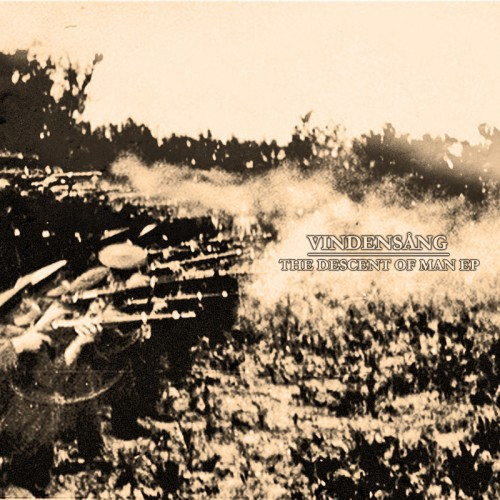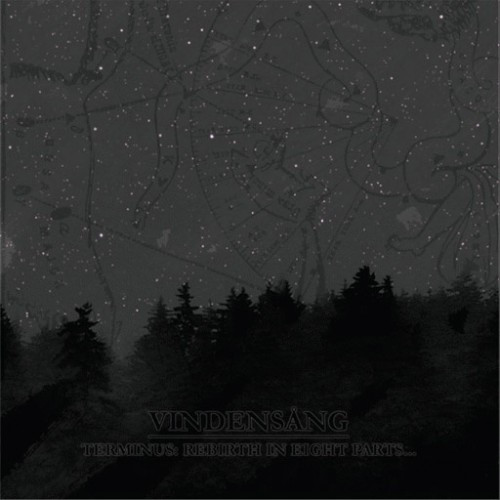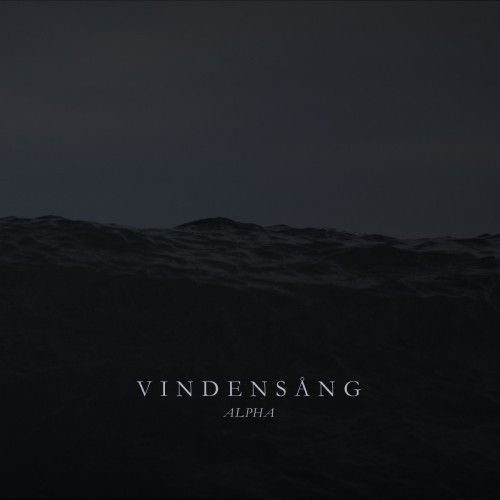(For the 58th edition of The Synn Report, Andy Synn reviews the discography of Vindensång.)
Recommended for fans of: Agalloch, Ulver, Altar of Plagues
I’m going to throw a bit of a curve-ball your way with this edition of The Synn Report, as we tack smoothly away from the brutal and the bombastic towards calmer, more atmospheric waters. And, yes, I know that’s a mixed metaphor. Just go with it.
Hailing from the dark and forbidding depths of… Pennsylvania (cue thunder and lightning), the Ambient/Post-Black/Neo-Folk triptych who operate under the moniker of Vindensång have so far produced two albums and one EP to their name, with last year’s phenomenal Alpha providing (in my humble opinion) one of the most compelling and captivating listening experiences of the year, exploring the depths of negative space and droning Post-Metal dynamics in a truly unique and unforgettable manner.
Though large swathes of the band’s sound seems distinctly un-Metal, there remains something… something in the emotions they evoke and the sonic textures they create… that still feels intimately familiar, hinting at a strain of blackened marrow in the band’s soul, one which colours and shades every rippling acoustic passage and ambient bloom with a morose and desolate grace.
THE DESCENT OF MAN – 2008
The band’s debut EP proper (following on from the extremely limited release of their Themes of Snow and Sorrow demo) remains a digital-only release, though that shouldn’t deter you from tracking it down as soon as you can as, despite lacking physical form, it’s a deeply engrossing experience, one more akin to an electronic soundtrack than a traditional EP.
It begins with the post-apocalyptic ambience of “The Descent of Man”, Part 1 of which is a droning, minimalist soundscape of deep shadows and drifting electron static, built around a piercing, cyclical siren and a slowly pulsating digital heartbeat, while Part 2 is a singular study in isolation, where a series of distant, distorted cries echo out against the shimmering background of softly-glowing radiation.
Continuing the sensation that the EP was written and conceived (and is best experienced) as one long, pervasive soundtrack, “Mountains of Bone” melds seamlessly out of “The Descent of Man: Part 2”, its faint radio waves and slow Doppler shifts failing to disguise the sound of distant gunfire, these growing sounds of battle eventually overtaken by the return of the menacing siren song as “Nuclear Winter” begins.
The ambient keys and sparse synthetic notes of the track seem half-heard and half-formed, existing right on the very edge of perception, fading to almost nothing as the song drift towards its (anti)climax, out of which rises the poignant and haunting “The Fall of Rome”, which features a recording of FDR’s “Let Our Hearts Be Stout” – a poem written and delivered by the President himself for the D-Day landings – over the top of a sequence of oddly unsettling background layers and eerie synth noises, bathed in the menacing shadow of war.
https://vindensang.bandcamp.com/album/the-descent-of-man-ep
TERMINUS: A REBIRTH IN EIGHT PARTS – 2008
For their first full-length release the band produced eight interlaced pieces of contemplative and atmospheric artwork, whose more naturalistic style and cosmic outlook signified a significant shift from that of their previous EP, exploring the metaphysical nature of life and death, in progressive, experimental style.
The ethereal strains of “Prologue: The Advent of Autumn” open the record with a glimmering procession of starlit ambience and whispered vocals, overlain with touches of tremulous bass and soft acoustic chords, whose ambient undercurrent melds seamlessly into the crashing waves and solemn gloom of “A Place Where Sand Meets Fog”, a song which sets you adrift for eleven-and-a-half haunting minutes, on phantom tides of ghostly ambience and sombre strings, with only the wraith-like vocals of J. Neblock as your guide among the growing shadows and silence.
The transition into “Return My Flesh and Bones to the Earth” is almost imperceptible at first, yet as the last flickering embers of the preceding track fade away a new fire begins to rise, a slowly building, slow-burning squall of dissonant noise and harsh, cracked vocals, threatening to subsume and consume the faint threads of melody which hold the track together, yet never quite reaching the point of ultimate combustion.
The gorgeous acoustic guitar that opens “Ashes and Memories” is a balm to the wounded soul, layered with barely tangible touches of softly-spoken vocals and plaintive melody, leading the listener into the stirringly epic “Dusk: into the Glow of Nightfall”, a twelve minute piece of dreaming ambience and lambent beauty, with an oddly reverential and hymnal undercurrent.
There’s an air of subtle menace to the start of “Fading Light”, Neblock’s hushed and breathy tones extolling a litany of loss and isolation as the track slowly begins to unfurl, its gleaming layers of fragile melody and drifting, hypnotic harmonies blossoming like frail petals from cleanly plucked and softly strummed guitars.
“The Origin: The Point of No Return” conjures an otherworldly atmosphere of sorrow and resignation, its murmuring melody lines and twinkling piano keys echoing into a vast and desolate void whilst its brittle vocals implore the listener, again and again, to “leave this body behind”, as the song begins its journey towards the beckoning stars, energized by some truly sublime and soaring guitar work.
The album concludes with the eight and a half minute instrumental finale of “Epilogue: At Winter’s End”, a mesmerising, minimalist soundscape that flickers and fluctuates on the very edge of your perceptions, never fully seen or fully heard, like the faintest ghost of a half-forgotten memory.
https://vindensang.bandcamp.com/album/terminus-rebirth-in-eight-parts
ALPHA – 2014
Thought it took a long six years for the group’s follow-up to Terminus… to emerge, it was more than worth the wait, with the band striking a brilliant balance between the esoteric and linear experimentalism of their previous works and a newer, more song-focussed approach (also incorporating the deft and subtle keyboard touches of the band’s long-time collaborator Justin Foley).
The album’s opener, the evocative “The Eternal Return”, slowly takes on solid form as the minutes progress, with Neblock’s hypnotic vocals – by turns a solemn whisper or a barely suppressed snarl – backed by a subtle array of ringing post-rock/post-metal guitars, reverb-drenched drum work, and chiming notes of starlit keys.
“Into The Formless Void” has a similar immediacy to it (though that’s a relative term here) when compared with much of the material from Terminus…, the slow procession of rippling chords and breathy vocals which open the track soon joined by an unexpectedly metallic and doomy drum performance, its radiant, electrified guitars ebbing and flowing between abstracted ambience and graceful, restrained, power, leading into the dreamlike haze of “One Thousand Fathoms”, which leans far more on the ambient and experimental side of the band’s repertoire, simultaneously both ominous and soothing in equal measure.
“Lights of the Abyss” actually recalls perennial NCS-favourites Solstafir at first, with its softly splashing cymbals and background of echoing ambience, though this impression is rudely shattered by the crashing, electric chords and thunder-crack drums which impose themselves suddenly and without warning. Though the track seems destined to sink back into the silence after this, instead it retreats to the abyss only to re-emerge once more, a series of chilling harmonies and potent drum patterns building to a subtly blackened, doom-laden finale.
The dramatically dynamic, ever-shifting colossus that is “Within the Womb of Creation” (all 18 minutes and 57 seconds of it) is the album’s centre-piece, a masterpiece of light and shade, yin-and-yang dynamic shifts, and majestic world-building grandeur that rivals the much-missed Altar of Plagues at their very best. Moments of haunting calm or melancholy melody provide a welcome respite from the heaving, dramatic nature of the song’s composition, its droning, gargantuan weight at odds with the seemingly fragile nature of so many of its elements. Mere words seem insufficient to describe the many layers and movements it incorporates, or the calm, yet compelling, power that it generates.
The album concludes with the meditative ambience of “Water-Bearer”, whose soothing waves of sound and silence wash over the listener like a tender tide, slowly lulling you back into endless slumber and eternal sleep.





I’m definitely an Ulcer fan, and this is really gorgeous stuff 🙂 nicely done!
Thanks. Alpha really is an absolute masterpiece.
It’s just unfortunate that it doesn’t seem like many people have engaged with this one!